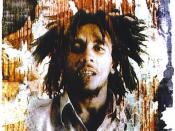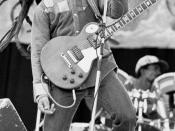Bob Marley and The Red Hot Chili Peppers
1. Red Hot Chili Peppers= Rock, Punk/Psychedelic Rock, Alternative
2. Bob Marley= Reggae
While both groups managed to heavily influence the mainstream pop music and social culture, the powerful lyrics and themes of Bob Marley and The Red Hot Chili Peppers have amazingly passed the test of time, and had a profound impact on the music industry as we know it today. Looking into the life of Bob Marley, one will see that he was a hero figure, in more than just the classic mythological sense. His vision of One World, One Love was to be heard and felt. Similarly with the Red Hot Chili Peppers, their music has gone through a shifting variety of topics, but through the times has held the same spirit of Bob Marley with love and friendship. As one looks into the message sent through these groups, they will find the absolute foundation of what has both sculpted society and encouraged diversity.
This message shatters all man made barriers of race or religion and has the ability to unite us all together as one.
Few people throughout history had such a firm and yet meek impact on music and philosophy as Bob Marley. Bob Marley overcame discrimination, political oppression, gangland warfare and the lack of a father figure in his adolescent life. He spread his beliefs and support of Rastafarianism across the globe with a docile yet infinitely effective technique, music. His music shared with the world a peaceful alternative to the oftentimes-violent situations that frequently arise in our society today. In a sense his music also carries an aspect of blues with it; for any given situation of despair or umbrage a person might experience there is a Bob Marley track to free the soul.
Robert Nesta Marley was born on February 6, 1945, the son of Cedella Booker and a fifty-year-old white quartermaster attached to the British West Indian Regiment, named Norval Marley. Although Norval did provide financial support, the constant pressure applied by his family as well as the rough environment of St. Ann and the lack of a fatherly presence made Bob's childhood a hard and impoverished one. When Bob Marley was barely in his teens, his mother became fascinated with the aspect of moving to the capital of Jamaica, Kingston. Kingston was falsely tagged as the "Land of Opportunity" during that time period, an illusion that Bob's mother fell victim to. The truth of the matter was that Kingston had little to offer in terms of work and lifestyle improvement. Bob Marley and his mother Cedella moved to Kingston in the late 1950's and soon settled in Trenchtown. (BobMarley.com)
It was in Trenchtown that Bob became enthralled with music, as well as meeting some of his comrades. He met Neville O'Riley Livingston, nicknamed Bunny, as well as Peter Macintosh. Through American radio stations Bob Marley and his companion Bunny were acquainted with the music of Ray Charles, Fats Domino, Curtis Mayfield and Brook Benton. They also grew a liking for black vocal groups like The Drifters, who were extremely popular in Jamaica at the time. Bob quit school so that he could further enhance his musical ambitions. He got a job at a welding shop, but he spent his free time perfecting his vocal skills with his friend, Bunny. During this period he met Joe Higgs, a reputable singer who held vocal lessons for upcoming vocalists. During one such lesson Bob and his friend Bunny met Peter McIntosh, yet another young man of colossal musical ambition. With the recommendations of Joe Higgs, Bob auditioned for a local entrepreneur named Leslie Kong. Somewhat impressed, Kong encouraged him to make an album, which he did. The first track to reach an album, "Judge Not" was released under "Beverley's Label." Although the track "Judge Not", as well as two others he had produced, received little airplay or other forms of attention, they set the foundation for what was soon to be a musical awakening. (Moskowitz 8)
After months of contemplation, Marley decided the best way to advance was in the form of a group. He relocated his friends Bunny and Peter McIntosh and they started a band called the Wailing Wailers. The group's first single, "Simmer Down," was released at the end of 1963. Within a month's time the track was number one on Jamaican musical charts, a position it held for two months. The track met competition with "ska" music, a dance floor sensation with a defined backbeat. "Ska" music was somewhat influenced by African radio stations, but more so from New Orleans rhythm and blues. It was at this time that Bob Marley began to impact Jamaican as well as American Music. The popularity of the Wailing Wailers, as well as that of "Simmer Down" had given them the popularity and funding they needed to ascend. They began to identify with other themes at this point, the primary theme being that of life in tough urban Kingston. Although this theme was known as taking a rough stance, the Wailing Wailers helped to mitigate the anger involved and instill a more tranquil overtone. Although the group had skill and influence in abundance, their lack of knowledge in planning, management and finances proved too cumbersome for the group to shoulder. (BobMarley.com 3)
By 1966 Bob Marley had married a young girl named Rita Anderson and his mother had moved to the United States. Cedella had also remarried and invited Bob to come visit her, with the intention that he would start a new life. Bob lived in America for eight months and spent all his resources attained there to finance his musical ambitions. Bob moved back to Jamaica after only eight months in the United States. By the time he resettled in Jamaica the Rastafarian movement had gained significant statute. Marley reunited with the Wailing Wailers and they opted to simplify their name to "The Wailers." The group committed to Rastafarianism, which proved to be a huge turning point in of all their lives. It was under this platform that Marley escalated to world renown and influence. Their claim to fame faltered, however when their own record label, "Wail 'n' Soul" collapsed in 1967, again due to a lack of economical understanding. Where the group's record label had stumbled the group persevered. They then came into contact with Lee Perry during their release of "Stir it Up," an international favorite. The addition of the musical creativity of Lee Perry resulted in the production of what some think is the greatest music the band ever made. Some of the tracks included: "Soul Rebel," "Duppy Conqueror" and "Small Axe." It was then that the group laid the foundation for the future of reggae. The reputation of the Wailers increased with the addition of Aston and Carlton Barret, as well as from their work with Perry's studio Band. Their accomplishments were great, and their influences many throughout the Caribbean, but one monumental goal still loomed ahead - that of international recognition. (Moskowitz 69)
Marley and the Wailers accepted an invitation from Johnny Nash in 1971 to accompany him to Sweden. While there, they signed a contract with CBS and hoped to produce a single that they could promote in order to broaden their horizons. Instead, with a turn of bad-luck and again, financial incompetence, they were stranded in Britain. In a foreign country with no way to get their message or music out, Marley took a huge risk with Island Records. He discussed the possibilities and implications of the proposition with the founder, Chris Blackwell. The company had a reputation promoting and recording Jamaican music. Fortunately for Marley and the Wailers, Blackwell was aware of their reputation and offered them a deal they couldn't refuse. He fronted them money to create an album, as well as allowing them access to top notch recording facilities, upgraded packaging, and unparalleled touring possibilities. They produced their first album under their new cover, entitled "Catch a Fire." Although not an immediate hit, the album illustrated the group's contrast to mainstream rock. Their long awaited dream of international acclaim and persuasion was beginning to take shape.
Blackwell realized the falcon he had under his wing, and offered the Wailers an opportunity to tour America and Britain - something unheard of for reggae bands. After this successful and influential tour of Britain a current chapter of the Wailers came to an end and an old chapter was reanimated. Bunny grew eerie of all the traveling and his time spent on the road. He went back to Jamaica and was replaced by their long time friend and teacher, Joe Higgs.
Shortly after the group underwent the drastic substitution, their American tour was underway. Their influences and music drew sold out showings. Their tour also consisted of an engagement playing support for Bruce Springsteen. The tour bore so much fruit that another tour in autumn was organized as well.
Marley's international tour had created influence and stature that he and the group had only dreamed of. His realm of influence had circumnavigated the globe. His firm Rastafarian stance had taken residence with the Jamaican youth. He had spread the music of reggae and the teachings' of Rastafarianism abroad. He had gained such political repute that when he announced a free concert to be played in Kingston before a political election, assassins attempted to kill him. In the chaos that ensued Marley was only wounded and not killed. He went on stage days later and reinforced his influence by playing a set in defiance of his attackers. Such heroic resolve and dedication did not fall on deaf ears, as he was met by thousands of cheering fans and supporters. Marley's influences and dedication were infallible. (Moskowitz 76) The month before he died of cancer in 1981, he was given Jamaica's Order of Merit, the nation's third most important honor in recognition of his outstanding contribution to the country's culture. The roots of what Marley had started continued to grow after his death, and still do today. His impact can be seen and heard everywhere. His teachings and music are still held sacred by many today. Marley idealized equality, unity and self worth through his tireless touring, his abundance of caring for others and his principles of peace. (81)
Next, we will look into the lives, influences, and significances of the Red Hot Chili Peppers. The band's foundation lay in the friendship of three schoolmates, Anthony Kiedis, Michael Balzary, and Hillel Slovak, while they attended Fairfax High School in California back in the late early 1980's. Influenced heavily by the growing punk scene as well as funk (Parliament-Funkadelic, Sly & the Family Stone), they soon began to rehearse with another friend, drummer Jack Irons. Together they formed a band called Anthem School and began to cast their talent out into the music world. By 1983, Balzary had begun to go by the name "Flea," and the group changed their name to the Red Hot Chili Peppers. (Rolling Stone 1) Anthony Kiedis was born in Grand Rapids, MI, on November 1, 1962. After his parents divorced when he was 11-years-old, he moved with his father to Los Angeles. When he was young he spent time listening to Sly Stone, Grandmaster Flash and the Furious Five, and Stevie Wonder. He also enjoyed writing poetry and acting when he was in high school and was encouraged by band members to start putting his poems into music, which became the base of his hip-hop style lyrics. (Apter 11)
Flea was born on October 16, 1962 in Melbourne, Australia. His family relocated to Los Angeles while he was still a young. Flea was different from other teenagers of his time because his first musical love was jazz, instead of hard rock, as he concentrated on the trumpet while attending Fairfax High School. He was later taught how to play the bass by Hillel Slovak and was influenced by artists such as Bootsy Collins of Parliament-Funkadelic and John Paul Jones of Led Zeppelin. (Apter 5)
Hillel Slovak was born April 13, 1962, in Haifa, Israel. When he was five years old his family relocated to California. By his teenage years, he had discovered the hard rock sounds of Jimi Hendrix, Led Zeppelin, and Kiss, and began playing guitar along to his favorite records. Though Slovak died in a drug overdose in later years the band had made many changes through the years. The band went through countless guitarists and several drummers the band currently consists of Kiedis, Flea, and John Frusciante on guitar, and Chad Smith on drums. (Foege 52)
The Red Hot Chili Pepper's style can be categorized as a blend of funk and punk rock but to describe the sound The Red Hot Chili Peppers create you have to break the band down into the members' styles and influences. Each band member has individually contributed different styles resulting in their unique sound.
First off, Anthony Kiedis provides a range of vocal styles for the songs, though his singing ability is limited, with his style of rapping and spoken verse complemented with more traditional vocals have helped the band maintain a relatively consistent style. Flea's bass style is mostly a blend of blues and funk. The grooved, low-tuned melodies, composed through either slapping or normal finger style, have contributed to the Red Hot Chili Peppers' signature style that has been copied by many different artists. Replacement players appear to have tried to stay as close as possible to original guitarist Hillel Slovak's style with its heavy blues and funk elements. However, during his short time with the band, Dave Navarro focused on his natural style rooted in heavy metal, and progressive. Current guitarist John Frusciante brings a deeper more melodic sound, while Chad Smith creates rhythmic grooves on his beats. Chad is mostly known for his extensive ability to put his feeling into the drum set. His cymbals are expressively loud, which definitely contribute to the Red Hot Chili Peppers' sound.
The Chili Peppers' style is heavily tied to the history of rock because of their unique blend of style mixed with the bands crazy stage antics. The incorporation of funk, metal, punk, hip-hop and other styles gave The Red Hot Chili Peppers in innovative sound. The wild on-stage antics like the strategically placed sock over their nude bodies during performances can only be accredited to The Red Hot Chili Peppers. The success of the band's albums in their genre is incomparable to many as well. Their albums have sold approximately 60 million copies worldwide.
In the album, Freaky Styley, The Red Hot Chili Peppers invent a unique musical mutation that borrows songs from Sly Stone and the Meters ("If You Want Me to Stay") along with moves from George Clinton and James Brown. The Peppers' hard funk might appear to be an imitation of "black" music for a white audience, but they're actually rude, punk rockers with a need for rhythm & blues and a commitment to humor, variety and independent sense of style. In the past musicians have always experimented with taking different elements of different cultures and they made a break through combination in this album. The Chili Peppers took advantage of the current crossover, white and black, to universalize funk by expanding its limits and incorporating new ingredients without taking away from the flow.
The Red Hot Chili Peppers have maintained commercial and critical success since their breakthrough BloodSugarSexMagik was released in 1991. For the album they signed on rap and metal impresario Rick Rubin as their producer and swapped their frustrating tenure with EMI for a fresh deal with Warner Bros. The band's change is thought to have had a lot to do with them getting sober and taking their craft much more seriously (Foege 52). Though the Chili Peppers have not shown much rebellion or have not run into many problems with expressing their artistic freedom I do not believe that they are towing the industry line. The Red Hot Chili Peppers have shaped and reshaped the way that they write and perform music. Some may argue that in this process they have conformed to more of what the labels want them to write, but I believe it is just that they are softening their edges a little bit after all their years of being crazy.
Through looking at the biographies of both of these groups and musicians, it is important to notice how though each group is separated by their extreme styles of music, the central themes remain constant amongst the two groups. The themes of love, sex, peace, anti-war, and anti-government remain profound in both of these groups' music. It is because of their powerful stance on advocating these themes in their music that they have seen such success, and hold a significant spot in musical history today.
While music is a powerful tool in the hands of any musician, the ultimate creation lies in the hands of the proper artist. People have always found worth in music for its enjoyment in creating, listening, and the challenge that it poses to all involved; and as humans we always strive to make or create things in any way be it little or small. It is when artists like the Red Hot Chili Peppers and Bob Marley create music that we cannot help but be challenged to accomplish their goals and live the very message they send.
List of Sources
1. http://web.bobmarley.com/index.jsp
2. http://www.rollingstone.com/artists/redhotchilipeppers/biography
3. Moskowitz, David. Bob Marley: A Biography. Santa Barbara: Greenwood Publishing Group, 2007.
4. Apter, Jeff. Fornication: The Red Hot Chili Peppers. London: Omnibus Press, 2004.
5. Foege, Alec "Once death-defying clowns, the Red Hot Chili Peppers grow up to be sensitive white males." Rolling Stone Issue 719, Pg. 52 (1995): 52-60.


